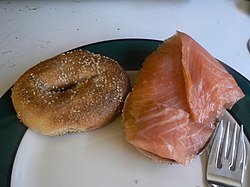I notice that we have two spellings of bagel (bagel) here so I looked it up with google.
First bagel:
From Wikipedia, the free encyclopedia
Jump to:
navigation,
search
For other uses, see
Bagel (disambiguation).

Bagel

A plain commercially produced bagel (as evidenced by grate marks used in steaming, rather than boiling)
Place of origin
Poland Region or state Central Europe Main ingredient(s) wheat dough Variations multiple


Bagels with
cream cheese and
lox (cured salmon) are considered a traditional part of American
Jewish cuisine (colloquially known as lox and a
schmear).
A
bagel (
also spelled beigel)
[1] is a
bread product, traditionally shaped by hand into the form of a ring from
yeasted wheat dough, roughly hand-sized, which is first boiled for a short time in water and then baked.
[2] The result is a dense, chewy, doughy interior with a browned and sometimes crisp exterior. Bagels are often topped with seeds baked on the outer crust, with the traditional ones being
poppy or
sesame seeds. Some also may have
salt sprinkled on their surface, and there are also a number of different dough types such as whole-grain or rye.
[2]
Bagels have become a popular bread product in the United States, Canada and the United Kingdom, especially in cities with large
Jewish populations,
[3] many with different ways of making bagels. Like other bakery products, bagels are available (either fresh or frozen, and often in many flavor varieties) in many major supermarkets in those countries.
The basic roll-with-a-hole design is hundreds of years old and has other practical advantages besides providing for a more even cooking and baking of the dough: the hole could be used to thread string or dowels through groups of bagels, allowing for easier handling and transportation and more appealing seller displays.
[4][5]
Second: Bagle
From Wikipedia, the free encyclopedia
Jump to:
navigation,
search
Bagle (also known as Beagle) is a mass-mailing
computer worm affecting all versions of
Microsoft Windows. The first strain,
Bagle.A, did not propagate widely. A second variant,
Bagle.B, is considerably more virulent.
Bagle uses its own SMTP engine to
mass-mail itself as an attachment to recipients gathered from the infected computer. It copies itself to the Windows system directory (Bagle.A as bbeagle.exe, Bagle.B as au.exe) and opens a
backdoor on TCP port 6777 (Bagle.A) or 8866 (Bagle.B). It does not mail itself to addresses containing certain strings such as "@hotmail.com", "@msn.com", "@microsoft" or "@avp".
The initial strain, Bagle.A, was first sighted on January 18, 2004. It was not widespread and stopped spreading after January 28, 2004.
The second strain, Bagle.B, was first sighted on February 17, 2004. It was much more widespread and appeared in large numbers;
Network Associates rated it a "medium" threat. It is designed to stop spreading after February 25, 2004.
Subsequent variants have later been discovered. Although they have not all been successful, a number remain notable threats.
Some of these variants contain the text
So now what is the color (colour) of your your bagel? And which is better pizza - from NYC or Chicago?































































